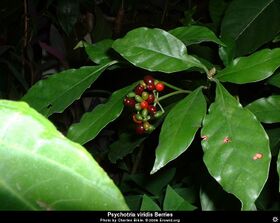Psychotria viridis
This article is a stub. As such, it may contain incomplete or wrong information. You can help by expanding it. |
| Psychotria viridis | |
|---|---|
| Taxonomical nomenclature | |
| Kingdom | Plantae |
| Unranked | Angiosperms |
| Unranked | Eudicots |
| Unranked | Asterids |
| Order | Gentianales |
| Family | Rubiaceae |
| Genus | Psychotria |
| Species | P. viridis |
| Common nomenclature | |
| Synonyms | P. psychotriaefolia[1] |
| Common names | Chacruna, chacrona |
| Constituents | |
| Active constituents | DMT, NMT |
Psychotria viridis (also known as Chacruna) is a plant in the Psychotria genus and the Rubiaceae family. It is an additive to the ayahuasca brew as a source of DMT.
Alkaloids
The leaves contain 0.1 to 0.61% N,N-DMT among trace amount of other alkaloids such as beta-carbolines, MMT and MTHC.[1]. The alkaloid content is said to be highest in the morning.[2]
Growing conditions
Psychotria viridis naturally occurs in rich, loamy, well drained soil. They prefer hot and humid environments and grow in partial shaded area, such as the tree canopy of Ecuador rain forests.
P. Viridis can be propagated from cuttings. They can grow from cuttings of a branch or from a single leaf which is a rare phenomenon in nature. The seeds are not a viable way of growing this plant as it can take up to 6 months for a seed to germinate compared to the few weeks for a cutting of a leaf.
Legal status
Psychotria viridis is currently legal in most countries except France. France is one of the few countries that both DMT and DMT containing plants are illegal. In the United States the plant itself is legal but the creation of ayahuasca (except for religious use) is illegal. The plant is legal in Australia but its import and export are illegal.
External links
See also
Literature
- Der Marderosian, Ara H., et al. 1970. The use and hallucinatory principles of a psychoactive beverage of the Cashinahua tribe (Amazonia basin). Drug Dependence 5:7–14.
- Pinkley, Homer V. 1969. Etymology of Psychotria in view of a new use of the genus. Rhodora 71:535–40.
- Prance, G. T., and A. E. Prance. 1970. Hallucinations in Amazonia. Garden Journal 20:102–7.
- Russo, Ethan B. 1992. Headache treatments by native peoples of the Ecuadorian Amazon: A preliminary cross-disciplinary assessement. Journal of Ethnopharmacology 36:192–206.
- 1997. An investigation of psychedelic plants and compounds for activity in serotonin receptor assays for headache treatment and prophylaxis. MAPS 7 (1): 4–8.
References
- ↑ 1.0 1.1 Rätsch, C. (2005). The encyclopedia of psychoactive plants: ethnopharmacology and its applications. Park Street Press. ISBN 9780892819782.
- ↑ Callaway, J. C. (1999). Phytochemistry and neuropharmacology of ayahuasca. Ayahuasca, R. Metzner, Thunder's mouth press, New York. pp-259-261.
